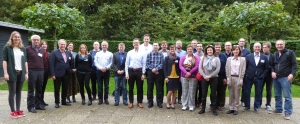Myotonic dystrophies, molecular approaches for clinical purposes. Framing a European molecular research network
- Number 248
- Date 11 October 2019
248th ENMC International Workshop:
Location: Hoofddorp, The Netherlands
Title: Myotonic dystrophies: molecular approaches for clinical purposes. Framing a European molecular research network
Date: 11 – 13 October 2019
Organisers: Dr D. Wansink (The Netherlands), Prof. G. Gourdon (France), Prof. B. van Engelen (The Netherlands), Prof. B. Schoser (Germany)
Translations of this report by:
German by Prof. B. Schoser
Dutch by Dr. D. Wansink
Swedish by Prof. A.B. Ekström
Spanish by Prof. R. Atero
French by Prof. Gourdon
Italian by Dr A. Botta
Polish by Prof. K. Sobczak
Participants: Dr R. Artero (Spain), Dr H. Van Bokhoven (The Netherlands), Dr A. Botta (Italy), Dr D. Brook (UK), Dr N. Charlet-Berguerand (France), Prof. E.B. Ekström (Sweden), Prof. B. van Engelen (The Netherlands), Dr A. Ferreiro (France), Dr D. Furling (France), Mr. A. Geille (France), Dr M. Gomes-Pereira (France), Prof. G. Gourdon (France), Mr. B. Haasakker (The Netherlands), Prof. J. Hall (Switzerland), Mrs. N. Loux (France), Dr C. Martinat (France), Dr P. Meinke (Germany), Dr D. Monckton (UK), Mr. K. Okkersen (The Netherlands), Mrs. L. Ripken (The Netherlands), Prof. B. Schoser (Germany). Dr K. Sermon (Belgium), Prof. M. Sinnreich (Switzerland), Dr K. Sobczak (Poland), Dr T. Vandendriessche (Belgium), Dr D. Wansink (The Netherlands),
Background and Aims of the workshop
Myotonic dystrophy is a rare disorder, characterised by huge genetic and clinical variability. This makes fundamental research and therapeutic approaches more challenging and warrants close international collaboration between experts in Europe. To ensure optimal sharing of existing materials, cell and animal models, protocols, partly unpublished data, refinement of suitable and harmonized outcomes, and new methods, close co-working is required. Moreover, networking of the existing knowledge, infrastructure and personnel will facilitate appropriate progress in research and improve communication between basic scientists and patients and patient organisations. The field of the myotonic dystrophies (DMs) has continued to progress and expand. Additional clinical cohort descriptions have been uncovered and two subtypes that are more precisely discriminated were associated with the DM1 and DM2 mutations, respectively. Given that DMs are at a critical juncture, with significant changes and therapeutic advances in the field as well as important unresolved issues and questions, we identified for this ENMC workshop two major aims:
Aim 1: The basic science of DMs. What do we already know and what do we urgently need to understand further?
Aim 2: Therapy development for DMs: where do we stand?
Workshop outcomes
Participants shared their expertise in research on a range of molecular mechanisms and therapeutic avenues. The still limited knowledge of the disease mechanism is one of the most significant barriers to drug discovery and development in the myotonic dystrophies. The workshop was dedicated to address this key gap by taking advantage of expertise from European academic scientists, patient representatives, and clinical DM experts.
We reviewed the understanding of the DM mutation and function, with an emphasis on the recent “RNA pathomechanism studies. We also reviewed the existing animal models and their role in therapy development. We tried to identify the key unknowns, defined the missing tools needed to advance research, and we formulated plans for how the required reagents can be generated and shared and how the important unknowns can be addressed. We summarized current therapeutic strategies and their status in relation to clinical translation in the European laboratories. We explored the barriers to new therapy identification and established an action plan fostering novel drug discovery in the future.
The consensus from the workshop was the establishment of a European Consortium that would share the diversity of expertise and material, methods, and patient data to inform therapy paradigms through a standardised and harmonized data set. Further details have to be elaborated.
Next steps
As first coordinated action, the group will apply for an EU-funded Innovative Training Network to ensure exchange and integration of young scientists.

A full report is published in Neuromuscular Disorders(pdf).
